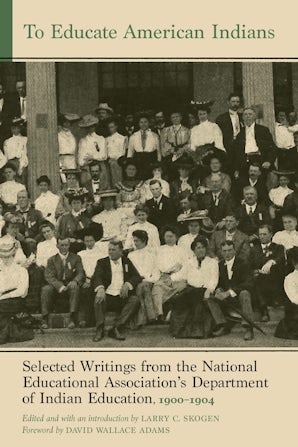List of Illustrations
Foreword, by David Wallace Adams
Acknowledgments
Introduction
Note on Editorial Style, Citations, and Names
List of Abbreviations
Part 1. Charleston, South Carolina, July 7–13, 1900 1. What Is the Relation of the Indian of the Present Decade to the Indian of the Future?
H. B. Frissell, Principal, Hampton Normal and Agricultural Institute, Hampton, Virginia
2. The Indian Problem
H. B. Frissell, Principal, Hampton Normal and Agricultural Institute, Hampton, Virginia
3. The Proper Relation between Literary and Industrial Education in Indian Schools
A. J. Standing, Assistant Superintendent, Carlisle Indian Industrial School, Carlisle, Pennsylvania
4. The Training of Teachers for Indian Schools
Charles Bartlett Dyke, Director of the Normal Department, Hampton Normal and Agricultural Institute, Hampton, Virginia
5. Teaching Trades to Indians
Frank K. Rogers, Director, Armstrong-Slater Memorial Trade School, Hampton Normal and Agricultural Institute, Hampton, Virginia
6. The Training of the Indian Girl as the Uplifter of the Home
Josephine E. Richards, Head of the Indian Department, Hampton Normal and Agricultural Institute, Hampton, Virginia
7. Practical Methods of Indian Education
John Seger, Superintendent, Seger Colony School, Colony, Oklahoma
Part 2. Detroit, Michigan, July 8–12, 1901 8. President’s Address: Learning by Doing
H. B. Frissell, Principal, Hampton Normal and Agricultural Institute, Hampton, Virginia
9. Civilization and Higher Education
William T. Harris, U.S. Commissioner of Education, Washington DC
10. The Reservation Day School Should Be the Prime Factor in Indian Education
C. C. Covey, Teacher, Pine Ridge Indian School, Pine Ridge, South Dakota
11. The Unification of Industrial and Academic Features of the Indian School
O. H. Bakeless, Carlisle Indian Industrial School, Carlisle, Pennsylvania
12. What Shall Be Taught in an Indian School?
Calvin M. Woodward, Director, Manual Training School of Washington University, St. Louis, Missouri
13. An All-Around Mechanical Training for Indians
Frank K. Rogers, Director, Armstrong-Slater Memorial Trade School, Hampton Normal and Agricultural Institute, Hampton, Virginia
14. Practical Methods in Indian Education
Joseph W. Evans, Teacher, Chilocco Indian School, Chilocco, Oklahoma
15. Character Building among Indian Children
Cora M. Folsom, Teacher and Indian Corresponding Secretary, Hampton Normal and Agricultural Institute, Hampton, Virginia
16. The Day School: The Gradual Uplifter of the Tribe
Macaria Murphy, Teacher, Odanah Day School, Odanah, Wisconsin
17. The Necessity for a Large Agricultural School in the Indian Service
C. W. Goodman, Superintendent, Chilocco Indian School, Chilocco, Oklahoma
Part 3. Minneapolis, Minnesota, July 7–11, 1902 18. President’s Address
S. M. McCowan, Superintendent, Chilocco Indian School, Chilocco, Oklahoma
19. The Value of an Agricultural School in the Indian Service
S. M. McCowan, Superintendent, Chilocco Indian School, Chilocco, Oklahoma
20. The Value of the Outing System for Girls
Laura Jackson, Girls’ Manager, Carlisle Indian Industrial School, Carlisle, Pennsylvania
21. What Is Our Aim?
E. A. Allen, Assistant Superintendent, Carlisle Indian Industrial School, Carlisle, Pennsylvania
22. Needed Changes in Indian Schools
A. O. Wright, Supervisor of Indian Schools, Washington DC
23. The Value of Day Schools
James J. Duncan, Day School Inspector, Pine Ridge, South Dakota
24. Newspapers in Indian Schools
W. T. Harris, U.S. Commissioner of Education, Washington DC
Part 4. Boston, Massachusetts, July 6–10, 1903 25. President’s Address: Our Work, Its Progress and Needs
H. B. Peairs, Superintendent, Haskell Institute, Lawrence, Kansas
26. To What Degree Has the Present System of Indian Schools Been Successful in Qualifying for Citizenship?
H. B. Frissell, Principal, Hampton Normal and Agricultural Institute, Hampton, Virginia
27. An Alaskan Start toward Citizenship
Sheldon Jackson, General Agent of Education in Alaska, Washington DC
28. The White Man’s Burden versus Indigenous Development for the Lower Races
G. Stanley Hall, President, Clark University, Worcester, Massachusetts
29. Heart Culture in Indian Education
Charles F. Meserve, President, Shaw University, Raleigh, North Carolina
30. Tenure in the Civil Service
John T. Doyle, Secretary of the U.S. Civil Service Commission, Washington DC
Part 5. St. Louis, Missouri, June 27–July 1, 1904 31. Efficiency in the Indian Service
John T. Doyle, Secretary of the U.S. Civil Service Commission, Washington DC
32. Indian Music and Indian Education
Natalie Curtis, New York, New York
33. What’s in a Name?
Emily S. Cook, Office of Indian Affairs, Washington DC
34. Indian Names
Alice C. Fletcher, Ex-President of the Anthropological Society, Washington DC
Conclusion
Notes
Bibliography
Index
